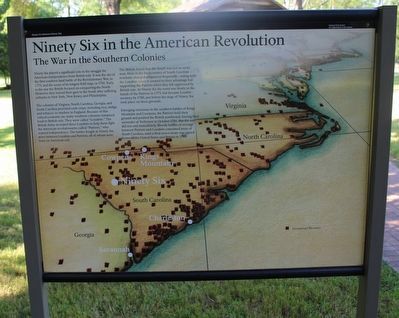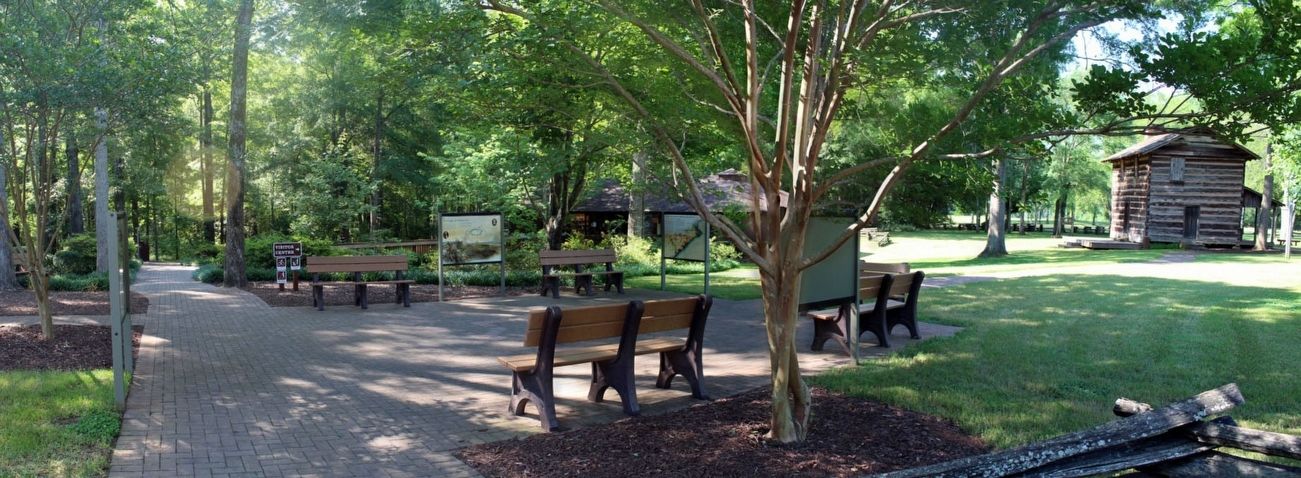Near Ninety Six in Greenwood County, South Carolina — The American South (South Atlantic)
Ninety Six in the American Revolution
The War in the Southern Colonies
The colonies of Virginia, North Carolina, Georgia, and South Carolina provided cash crops, including rice, indigo and tobacco, to markets in England. Because of this critical economic tie, many southern colonists remained loyal to British rule. They were called "Loyalists." The British Army recruited these Loyalists to help them fight the American revolutionaries called "Patriots," who wanted independence. The battles fought at Ninety Six were between Loyalists and Patriots, all of whom were born on American soil.
The British found that the South was not so easily won. Here in the backcountry of South Carolina residents changed alliances frequently — siding with the Loyalists when it seemed to their advantage but supporting the Patriots when they felt oppressed by British rule. At Ninety Six the town was firmly in the hands of the Patriots in 1775, but became Loyalist territory by 1780, just before the siege of Ninety Six took place on these grounds.
Emerging victorious in the southern battles of Kings Mountain and Cowpens, the Patriots held their ground and pushed the British northward, forcing their surrender at Yorktown in October, 1781. But the war did not end immediately. Bloody battles of revenge between Patriots and Loyalists consumed areas of South Carolina, until a final peace treaty was signed between the United States and Britain in 1783.
Erected by National Park Service: Ninety Six National Historical Site.
Topics. This historical marker is listed in this topic list: War, US Revolutionary.
Location. 34° 8.81′ N, 82° 1.397′ W. Marker is near Ninety Six, South Carolina, in Greenwood County. Marker can be reached from South Cambridge Street (State Highway 248) 1.2 miles south of Johnston Road (State Highway S-24-72), on the left when traveling south. Marker is at the start of a walking trail at a rest area outside the Visitor Center. Touch for map. Marker is at or near this postal address: 1103 Hwy 248 South, Ninety Six SC 29666, United States of America. Touch for directions.
Other nearby markers. At least 8 other markers are within walking distance of this marker. Why Is It Called Ninety Six? (here, next to this marker); The Siege of Ninety Six (here, next to this marker); Ninety Six National Historic Site (a few steps from this marker); Walking Tour of the Park
(within shouting distance of this marker); Logan Log House (within shouting distance of this marker); a different marker also named Logan Log House (within shouting distance of this marker); 96 (about 300 feet away, measured in a direct line); Monument to James Birmingham (about 400 feet away). Touch for a list and map of all markers in Ninety Six.
Regarding Ninety Six in the American Revolution. The marker includes a map showing a large number of Revolutionary battles fought in the southern colonies.
Credits. This page was last revised on July 13, 2016. It was originally submitted on July 13, 2016, by David Graff of Halifax, Nova Scotia. This page has been viewed 344 times since then and 18 times this year. Photos: 1, 2. submitted on July 13, 2016, by David Graff of Halifax, Nova Scotia.

